
SATURDAY, FEB 27, 2016

Bliss Indicator Names
Name that Indicator
Eric Lee, A-SOCIATED PRESS
TOPICS: CHARLES K. BLISS, SEMANTOGRAPHY, BLISSMBOLICS, LOGICAL LANGUAGE
TUCSON (A-P) —
Indicators that may occur at the top of characters are named first. Read the shape from left to right and top down. So reading X (means plural) from the left, both lines are met, but from the top down, you see the \ line first, called [pede]. The other is [mede]. Together the [de] cancels out and the X shape is called [peme]. All indicators are size 1/3 [s] so no need to specify the size of peme. A full size [peme] is [pemeg] and a 1/2 size [peme] is [pemel] that means "many, a group of" a sort of indicator meaning. X is an elemental character made of two elemental line shapes.

Rotate [peme] and get +, or [@r] + [I] = [@rI]. This word can be spoken, but to go for a one sylable name, drop [@] and phonetically shift [rI] slightly to [ri], much easier to type, so + is [ri] as in "reap" to reap the benefits of boiling it down.
The thing indicator is a small box  made up of four lines called [I] and [@r], two of each. So we could call "box" [@rII@r]. But as box is elemental, shorten to [II@r]. But two short i's sort of makes a long i, or [i]. In English [i@r] is "ear" or [ir] and [ir] "ear" is "box."
made up of four lines called [I] and [@r], two of each. So we could call "box" [@rII@r]. But as box is elemental, shorten to [II@r]. But two short i's sort of makes a long i, or [i]. In English [i@r] is "ear" or [ir] and [ir] "ear" is "box."
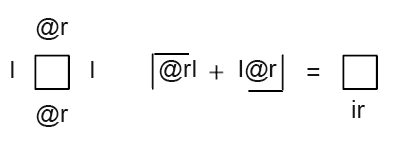
Next to "things" are the things that things do, actions indicated by ^, a sort of A for Action shape without the horizontal bit. So reading from the left, is / [mefe] then \ [pefe], so action is [mep] in short.
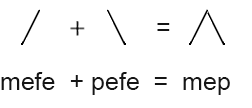
Next is the valuator indicator V, which is \ [pefe] and / [mefe] or [pefemefe] that goes to [peme] and then to [pem] that says "evaluation" V shape. The valuation indicator is one of the big three, and gets its name:
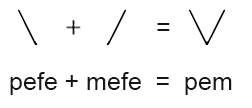
Know them and love them. The rest have names, which refer the to ASCII characters rarely spoken of. As a Bliss elemental character, they can be renamed if need be. When speaking Blisspeak or writing Blisscript, the last sound can be omitted. For [mep] before a vowel use [m] or ]me] before a consonant. For [pem], it may be shortened to [p] or [pe] if meaning remains clear.
ASCII names
< [ibijin]
> [inijin]
( [iin]
) [ijin]
? [imijin]
+ [iujin]
1 [an]
2 [bin]
3 [cin]
Bliss Indicator Names
[ir] "ear"
^ [mep] "mape" or m me
v [pem] "paim" rhymes with "pain" or p pe
< [bi] "bee"
> [no] "know"
x [peme]
( [i] "ee"
) [o] "oh"
? [qe] "kay"
+ [ri] "erih"
0 [jin] "yean"
1 [an] "on"
2 [bin] "bean"
3 [cin] "cheen"
.V [@pem] "uh-paim" or [@p] typed .p
V. [pem@] "paim-uh" or [p@] typed p.
- [@r] "uhr" as in "earth" or .r
The ASCII name for < [ibijin] and > [inijin] is too long. < > is like ( ), open-close shape, that grammaticly indicates < passive and > active. The ASCII names differ by their second letter, so < > goes to [b n]. Add ( ) [i o] and get [bi] and [no] for < and > as Bliss elemental characters.
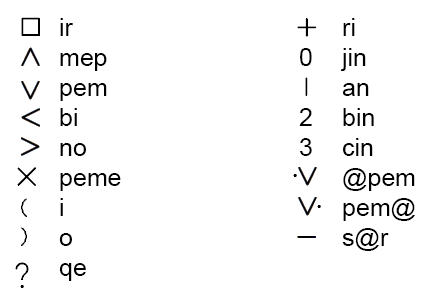
Mid Indicators
The pointers differ from indicators v ^ < > made from 30 or 60 degree lines in that they are made of 45 degree lines. Mistaking one for the other is avoided by never using them in the indicator position. Their line names:
^ [mede+pede] as read from left to right
v [pede+mede]
< [mede+pede] as read top to bottom
> [pede+mede]
For left right we have right parenthesis ( [i] and left parenthesis ) [o], and for upper lower we have the elemental shapes of over (top) parenthesis [u] and under (bottom) parenthesis [a].
^ [mede+pede] pointing up [u], name as read from [i] to [o]
v [pede+mede] pointing down [a]
> [pede+mede] pointing right [o], name as read [u] to [a]
< [mede+pede] pointing left [i]
To simplify:
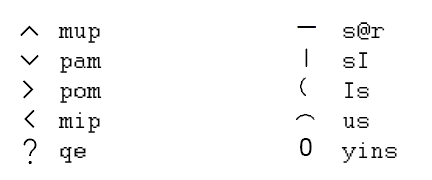
The left parenthesis is used to indicate "hair" when used three times in a row. The over parenthesis indicates claws on a feline, raptor-like bird, or other animal that uses claws to procure prey.
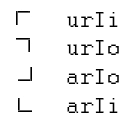 The mid-pointers are used within a circle to point north, south, east, west, but also northeast, northwest, and so on. This requires four /3 sized angle shapes to point with. The two line shapes needed to make them are [.rs] and [Is] which will boil down to [rI]. So [.rsIs] with the [Is] going down makes the indicator points to the northeast. To indicate its upper position, start with [u] or [a] infront of [rI] then [i] for left pointing or [o] for right pointing. So northeast is [urIo].
The mid-pointers are used within a circle to point north, south, east, west, but also northeast, northwest, and so on. This requires four /3 sized angle shapes to point with. The two line shapes needed to make them are [.rs] and [Is] which will boil down to [rI]. So [.rsIs] with the [Is] going down makes the indicator points to the northeast. To indicate its upper position, start with [u] or [a] infront of [rI] then [i] for left pointing or [o] for right pointing. So northeast is [urIo].
Two more mid-indicators are horizontal and vertical lines that are alway 1/3 sized [s]. So - [@r] and | [I] have names and add [s] to get: - [s@r] "sar" and | [sI] as in "Sid." Since [@] means "dot" another way to type it is using a period, so [s@r] is easier to type as [s.r].
[sI} is used to indicate 1 "one," or line, and is placed over 0 to indicate "digital" as in binary numbers. So 0 is also included as a mid-indicator. 0 is [jin] and as a mid-indicator 0 is [jins], so [sIjins] is Bliss for "binary" or "digital."

A 1/3 sized circle is a shape but not an indicator, so not used where [sIjins] might be used. The character is Bliss for AI, or binary mind.
The last mid-indicators are 1/3 sized commas, normal left commas and mirror right commas with the tick going to the right. They combine to make readable quote marks, opening and closing. Since the comma shape, like dot, is elemental, it's name is [ob] for left normal comma shape and [ib] for right comma shape. They are used together to make open quote [ibib] and close quote [obob] and so will not be mistaken for double (( or )) parentheses which have no meaning in Bliss. Used together they make several small characters that could be used.
FoBliss Indicators
2.gif)
For testing, new indicators can be considered. Currently some with an apparent interest in language anyalisis have added indicatores for parts of "spech" or grammar. Grammarians love them, but they hopefully will never be required to write Bliss. FoBliss considers adding /3 sized indicators that would be used. Moving parts of Bliss that are in effect indicators into the indicator area is logical and makes characters more compact to save paper or reduce the number of clay tablets when writing books.
Migrating the possessive indicator and first, second, third person indicator up has been done and is favored by FoBliss. C.K. Bliss favored using the opposite character  to change the meaning of a character to its opposite.
to change the meaning of a character to its opposite. 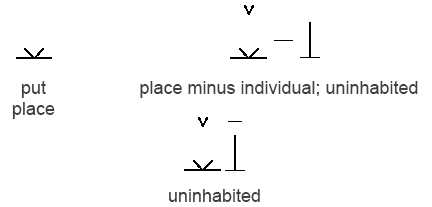 BCI Bliss has moved away from doing so by using the minus sign instead. It is typically added inline with the character it negates. Moving it into the indicator as a /3 sized negation sign is alternative and will save clay.
BCI Bliss has moved away from doing so by using the minus sign instead. It is typically added inline with the character it negates. Moving it into the indicator as a /3 sized negation sign is alternative and will save clay.
Moving characters up is limited by their readability. C.K. Bliss uses the "mind" character, full sized, as an indicator by putting it in the "sky" area. Some use a /4 sized exclamation mark in the indicator position but when Bliss is printed in books, /4 is too small to tell the difference between l[I!|] and other vertical characters. At /3 size only one vertical character works.
A small /2 circle in the sky means metaphore. In FoBliss there is no space above for other indicators so they are put to the side or superimposed. An analysis of BCI Bliss fournd 7 characters with indicators above other indicators, a convention that would make books use 25% more material. In all cases simply moving to the side or superimposing avoids the wasted space.
 FoBlliss currently adds three indicators. A short individual indicator for "person" so if the character means "bake" adding
FoBlliss currently adds three indicators. A short individual indicator for "person" so if the character means "bake" adding  means "baker." Many Bliss characters are preceeded by a full-size individual sign which can be shortened and moved into the indicator position. "Individual" before "fight" means "fighter" and adding "many" means a fighting force, as in army. Moving both up means the same "many fighters" or "army" if fighting on land.
means "baker." Many Bliss characters are preceeded by a full-size individual sign which can be shortened and moved into the indicator position. "Individual" before "fight" means "fighter" and adding "many" means a fighting force, as in army. Moving both up means the same "many fighters" or "army" if fighting on land.
 Two other common indicators mean "more" and "most" which in CK Bliss are indicated by putting a bar under the X that means "many." Up from the many are the more, as Marines are more better fighters on average than regular army. So "army" becomes "marines" by adding a bar under the X.
Two other common indicators mean "more" and "most" which in CK Bliss are indicated by putting a bar under the X that means "many." Up from the many are the more, as Marines are more better fighters on average than regular army. So "army" becomes "marines" by adding a bar under the X.
 Of course, in the US fighting land forces the Green Beret are elite fighters, even more than Marines, they are the most effective fighting force. Move the bar to the top of the X to indicate "most." The Bliss character doesn't mean "Green Beret" as every fighting force has elite fighter who are the most good.
Of course, in the US fighting land forces the Green Beret are elite fighters, even more than Marines, they are the most effective fighting force. Move the bar to the top of the X to indicate "most." The Bliss character doesn't mean "Green Beret" as every fighting force has elite fighter who are the most good.  To indicate which army add "USA" or other name for current nation states or other fighting forces. The navy fights on water, and US Navy Seals are their elite force. FoBliss also experiments with superimposistion of characters. Instead of adding "water" after "fighting" it is put under which is readable and adds finghting "on" water.
To indicate which army add "USA" or other name for current nation states or other fighting forces. The navy fights on water, and US Navy Seals are their elite force. FoBliss also experiments with superimposistion of characters. Instead of adding "water" after "fighting" it is put under which is readable and adds finghting "on" water.
Other possible tweaks can be considered with the understanding that just because a change in Bliss formalism is possible doen't mean it would be made. No impairment in readablilty is allowable as Bliss is for readers, not writers. Stylistic variation could easly develops, as in natural languages, such that in 500 years English will likely be unintelligetable to current speakers. It is the nature of natural languages that primarily serve biological purposes to do so. Bliss, like mathematical formalism, should not involve the needs of fashion or to be fashionable. Both are focused on meaning and to be universal must tend toward one form as the community of users evolve it.

